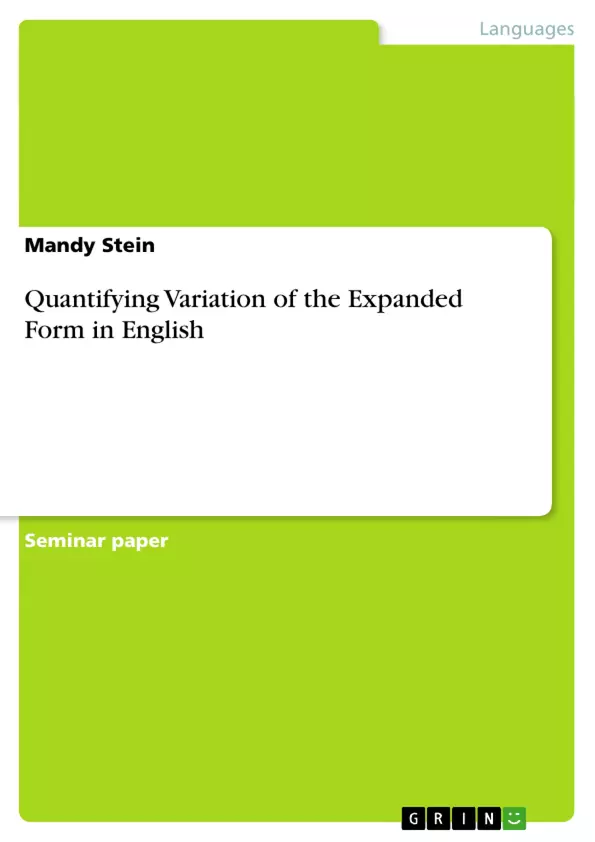The use of the Present/Past Progressive or as some people call it: Expanded
Form (EF)in English is part of the curriculum in schools and every students either
native speaker of English or a learner of it as a foreign-language must learn this
part of English grammar.
Next to German, where it is sometimes undefined when you do/did a specific task
it is specified in English by the progressive form. If you did something next to
another action happening you have to use the Progressive tense or if you are
doing something at the moment, like the reader of this term paper is reading at the
moment.
The topic of this term paper is the quantifying variation of the progressive tense
during its development from Old English to Modern English. Therefore I will use
works by Nehls, Denison and Strang on that specific field and combine them in
their resources with Visser which is one of the richest sources of older English to
find out if there are differences or one expands.
First, I am going to give a short summary of the work by the three authors.
Second, I will give an overview over the source constructions of the Progressive
Form (I will use the term ‘Expanded Form as well as ‘Progressive’ because the
composers switch between the two terms). In chapter three I will have a closer
look on the Modern use of the Expanded Form in English and in a fourth step I will
combine the old and modern usage of it to find out what was left or included during
the years. In chapter five I will have a closer look on the mini-corpus-studies by
Mossè and Nickel, who dealt with the emergence of the progressive and show
what changed since they started research on this field. And finally, I will draw a
conclusion about the position of the Expanded Form.
[...]
Inhaltsverzeichnis (Table of Contents)
- 1. Introduction
- 2. The Articles
- 2.1. Dietrich Nehls „Synchron-diachrone Untersuchungen zur Expanded Form im Englischen: eine struktural-funktionale Analyse"
- 2.2. Barabara M. H. Strang "Some aspects of the history of the Be+ing construction"
- 2.3. David Denison “English historical syntax: verbal constructions”
- 3. Source Constructions
- 3.1. The function of the EF in Old English
- 4. Modern Usage of the Progressive Form
- 5. Comparison of the old and new usage
- 6. Mossè and Nickel: sources for the progressive
Zielsetzung und Themenschwerpunkte (Objectives and Key Themes)
This term paper quantifies the variation of the progressive tense in English from Old English to Modern English. It analyzes existing scholarship on the topic to determine the differences and expansions in usage over time. The paper examines the functional and structural aspects of the progressive form, tracing its evolution and exploring its usage in different historical periods.- The historical development of the progressive tense in English.
- The functional and structural aspects of the progressive form.
- Comparison of the progressive form's usage in Old and Modern English.
- Analysis of existing scholarship on the progressive tense.
- Examination of the role of aspect and tense in the development of the progressive.
Zusammenfassung der Kapitel (Chapter Summaries)
Chapter 1: Introduction introduces the topic of the paper, focusing on the quantification of variation in the use of the progressive tense throughout the history of the English language. It outlines the methodology, which includes a review of relevant works by Nehls, Denison, and Strang, supplemented by Visser's research on older English.
Chapter 2: The Articles summarizes the key arguments of three influential works: Nehls' structural and functional analysis of the Expanded Form; Strang's historical overview of the Be + Ing construction, including its stylistic variations in novels; and Denison's treatment of the progressive in his work on English historical syntax, which incorporates previous research by Visser and Nehls.
Chapter 3: Source Constructions delves into the function of the Expanded Form (EF) in Old English. Further details of this chapter are not included here to avoid spoilers.
Chapter 4: Modern Usage of the Progressive Form examines the contemporary use of the progressive tense in English.
Chapter 5: Comparison of the Old and New Usage compares the use of the progressive tense in Old and Modern English, analyzing changes in frequency and function over time. Further details are omitted to prevent spoilers.
Chapter 6: Mossè and Nickel: Sources for the Progressive discusses the mini-corpus studies by Mossè and Nickel concerning the emergence of the progressive, and how this research informs understanding of subsequent changes.
Schlüsselwörter (Keywords)
The key terms and concepts explored in this paper include: Expanded Form, Progressive tense, Old English, Middle English, Modern English, tense, aspect, historical syntax, structural analysis, functional analysis, linguistic change, and corpus linguistics. The analysis draws upon the work of key scholars in the field, including Nehls, Strang, Denison, and Visser.- Quote paper
- Mandy Stein (Author), 2007, Quantifying Variation of the Expanded Form in English, Munich, GRIN Verlag, https://www.grin.com/document/119287



